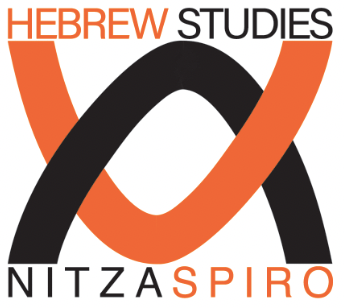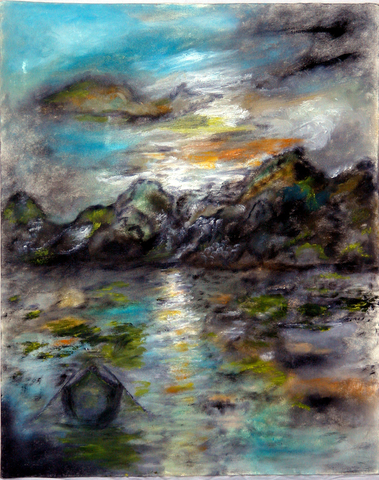-=-=-=-=-=-=-=-=-=-=-=-=-=-=-=-=-=-=-=-=-=-=-=-=-=-=-=-=-=-=-=
Born in Adjud -- a town in Romania's province of Moldova (Moldavia) -- with a vibrant Jewish community exuding a life-style and atmosphere not dissimilar to those emanating from Shalom Aleichem's "shteitles", or as so vividly depicted by Marc Chagall's imagery of his own Vitebsk -- Maria'a childhood, youth, formative years [and one could safely say, the rest of her life] would be indelibly marked by the myriad of the Jewish friends, school-friends, neighbours, etc that were an integral part of her mini-universe...
In Maria Tudosa's own words: "Since my childhood, I have always admired the richness, diversity and vibrancy of Jewish life around me, and later on, its religion, its awesome contribution to civilization, and generally speaking, its unique impact on the world's culture, human development, but especially on its spirituality, ethics and morality".
However, the finely-poised, delicately-balanced, fragile but usually idyllic life of Adjud's Jewish community and its co-existence with its gentile hosts surrounding it, came to an abrupt and most dramatic end with the outbreak of the 2nd World War, when first, the latent, dormant, but perennial local anti-semitism came to the fore, soon to be augmented by the greater menace of the German Wermacht units stationed there.
It was then that Maria witnessed and was shocked by the ongoing indignities, humiliations, persecutions, deportations and worse, visited upon her next door neighbours, school or family friends.
During the short hiatus separating the ending of the horrors of the war and the onset of the Communist tyranny -- a new dark chapter in the lives of Romanians which would last until December 1989 -- Maria immersed herself with great gusto in the pursuit of art forms as diverse as poetry, ballet, theatre, classical music (singing with one of the most prestigious Romanian musical institutions, the George Enescu Philharmonic in Iasi (Yassi), and finally, more by accident than by design, painting. Although amazingly gifted in all above fields, it would be her poetry, but especially her painting where she would find the truest expression of her soul, ideas and ethos.
She had several exhibitions in her native Romania, as well as abroad, when she decided to join her daughter -- the Internationally-acclaimed Opera singer Nelly Miricioiu -- in England, where she exhibited in 1988 at the Summer Exhibition of the Royal Academy. It was during this time when she studied iconography, that she discovered her passion for spirituality, mysticism and surrealism.
Maria confesses that, as an artist, she wanted to try and paint about the Jewish experiences and tribulations, as seen and perceived by an outsider. Inevitably, in doing so, some of the subjects portrayed drew on one of the darkest episodes not only in Jewish history, but indeed in the whole history of mankind. However, as Maria puts it: "Where human suffering reaches such unbearable heights or depths, I do feel it is impossible for ~ art and life to truly imitate one another ~ except perhaps, when done by those who live, or have lived, through such experiences".
In Maria's view, Anna Frank is one such revered spirit, who has now come to represent in the world, all those known and unknown souls who made this journey, and her story as recorded in her Diary, reminds us also of our responsibility towards each other and the potential for "human goodness" we inherit, which was born out of her spirit and others like her.
In Anne Frank's own words: "In spite of everything, I still believe that people are really good at heart!".
As a confessed romantic and free-spirit, Maria was, inevitably, a fervent opponent of Romania's ruthless and soul-destroying Communist regime, and hence started to add a new dimension to her work -- the fight against totalitarianism in all its manifestations.
For Maria Tudosa, the depictions and subjects in all her paintings represent what she hopes can be seen as "the journey of the human spirit towards God" through many dangerous and dark landscapes and events, but always in the hope and belief of a final transcendence into light! It was to that spirit that she picked-up and used the brush in the first place.
Therefore, it was only logical that the 2 main themes represented in her output in this exhibition, would be inspired by her incessant preoccupation with the Shoah/Holocaust, the redemption of the Jewish people, as well as her relentless opposition to tyranny and the preservation of freedom and liberty.
A complex personality, a completely self-taught painter, her unique artistry was perhaps best described by Radu Negru, the doyen of Romania's art critics: "Maria Tudosa's varied creations reveal a poet's personality, with musical fictional visions, a poet contemplating the landscape, as well as human hope, oscillating between the natural and the supernatural!".
Maria Tudosa firmly believes in, and is confident of the fragility but also of the resilience of what Andre Malraux coined as "La condition humaine".
If one could also add George Elliott's dictum that "Art is the nearest thing to life", then those viewing her current exhibition should be in for a real treat!




